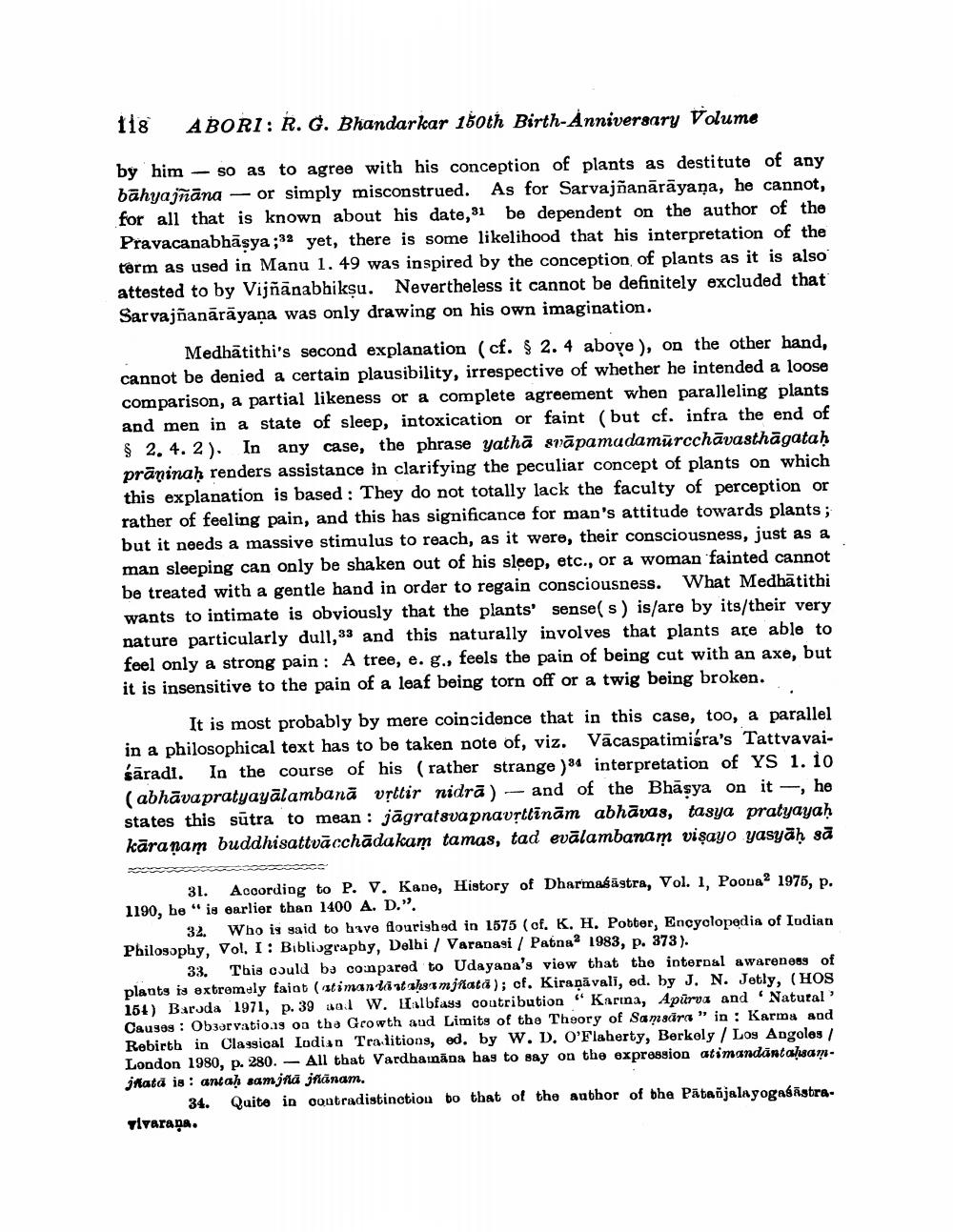Book Title: On Term Antahsamjna Author(s): A Wezler Publisher: A Wezler View full book textPage 8
________________ 118 ABORI: R. G. Bhandarkar 180th Birth-Anniversary Volume by him so as to agree with his conception of plants as destitute of any bahyajñāna - or simply misconstrued. As for Sarvajñanārāyaṇa, he cannot, for all that is known about his date, 31 be dependent on the author of the Pravacanabhāṣya;32 yet, there is some likelihood that his interpretation of the term as used in Manu 1. 49 was inspired by the conception of plants as it is also attested to by Vijñānabhiksu. Nevertheless it cannot be definitely excluded that Sarvajñanarayana was only drawing on his own imagination. Medhātithi's second explanation (cf. § 2. 4 above), on the other hand, cannot be denied a certain plausibility, irrespective of whether he intended a loose comparison, a partial likeness or a complete agreement when paralleling plants and men in a state of sleep, intoxication or faint (but cf. infra the end of 2.4.2). In any case, the phrase yatha sväpamadamürechāvasthāgataḥ präpinah renders assistance in clarifying the peculiar concept of plants on which this explanation is based: They do not totally lack the faculty of perception or rather of feeling pain, and this has significance for man's attitude towards plants; but it needs a massive stimulus to reach, as it were, their consciousness, just as a man sleeping can only be shaken out of his sleep, etc., or a woman fainted cannot be treated with a gentle hand in order to regain consciousness. What Medhätithi wants to intimate is obviously that the plants' sense(s) is/are by its/their very nature particularly dull, 33 and this naturally involves that plants are able to feel only a strong pain: A tree, e. g., feels the pain of being cut with an axe, but it is insensitive to the pain of a leaf being torn off or a twig being broken. It is most probably by mere coincidence that in this case, too, a parallel in a philosophical text has to be taken note of, viz. Vacaspatimiśra's Tattvavaisaradi. In the course of his (rather strange )34 interpretation of YS 1. 10 (abhavapratyayalambana veltir nidra) and of the Bhasya on it, he states this sutra to mean: jāgratsvapnavṛttinām abhävas, tasya pratyayah käraṇam buddhisattvacchadakam tamas, tad evälambanam visayo yasyaḥ sā Cooca 31. According to P. V. Kane, History of Dharmasastra, Vol. 1, Poona2 1975, p. 1190, he is earlier than 1400 A. D.". 32. Who is said to have flourished in 1575 (cf. K. H. Potter, Encyclopedia of Indian Philosophy, Vol. I: Bibliography, Delhi / Varanasi / Patna 1983, p. 373). 33. This could be compared to Udayana's view that the internal awareness of plants is extremely faint (atiman lantaḥsamjñata); of. Kiranavali, ed. by J. N. Jetly, (HOS 154) Baroda 1971, p. 39 and W. Halbfass contribution "Karina, Apurva and Natural' Causes Observations on the Growth and Limits of the Theory of Samsara" in: Karma and Rebirth in Classical Indian Traditions, ed. by W. D. O'Flaherty, Berkely / Los Angoles/ London 1980, p. 280. All that Vardhamana has to say on the expression atimandantaḥsamjata is: antaḥ samjñā jñānam. 34. Quite in contradistinction to that of the author of the Patanjalayogaśāstra vivaraja.Page Navigation
1 ... 6 7 8 9 10 11 12 13 14 15 16 17 18 19 20 21
